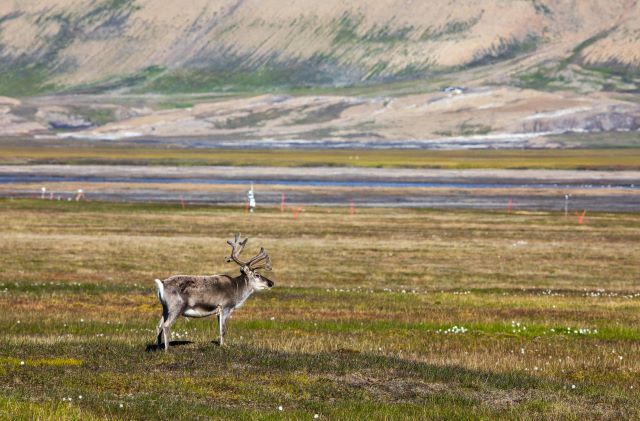
Iḷisaġvik College, in Utqiaġvik, Alaska, recently announced a grant from the National Science Foundation Tribal Colleges and University Programs to study microbes in the arctic tundra.
The $200,000 two-year grant supports student research into the varieties and concentrations of microbes in the permafrost, soil, and vegetation in the tundra around Utqiaġvik.
According to Iḷisaġvik College, students are looking for pathogenic bacteria that may harm human health as they are released by melting permafrost. One student described it as, “hunting an animal you can’t see.”
Linda Nicholas-Figueroa, associate professor of biology and chemistry, is the principal investigator on the project. Apart from a year-long hiatus during the recent pandemic, the project has been ongoing for more than five years.
Students drive all aspects of the project, going out into the field throughout the year to collect soil and ice samples with a core drill. They then process the samples, isolate and culture the bacteria, and extract DNA. To identify the bacterial species, samples are sent out to professional biomedical labs for sequencing and analysis. Students then do further research on the properties of these bacteria.
Students are also tapped to present their findings at conferences, including the American Society of Microbiology annual meeting and the Society for the Advancement of Chicanos/Hispanics and Native Americans in Science (SACNAS).
Two students, Daphne Mueller and Garrett Taylor, helped write the final report to the NSF for the first grant. Mueller and Taylor were dual credit students at Iḷisaġvik, taking college courses while attending high school at Barrow High School in Utqiaġvik. Both are now undergraduate students at the University of Alaska, Fairbanks (UAF).
The first grant supported research into microbes that could influence plants and animals in ways that might affect the diet.
Through their research, students found a direct link to health when they found a mycobacterium that can cause symptoms that mimic tuberculosis but require a different course of treatment.
The second grant continues this work, hunting for other pathogens or any changes in pathogen prevalence. Nicholas-Figueroa emphasizes that they are still establishing a baseline and it is too soon to draw any conclusions. However, it is not too soon to see the impact the work is having on students.
None of the students involved in the project had any prior experience, but several have gone on to continue their studies in biomedical research and other science-related fields.
“When I was in high school, I thought research was something for these people that were mega brainiacs,” says Nicholas-Figueroa. “It’s great that students get exposed to this, and they get paid.”
Weech, who is Nicholas-Figueroa’s current student worker, recently accompanied a half-dozen high school students out into the tundra with two meteorologists, and five UAF researchers, who are also funded by the NSF, on a field trip for the Arctic Perspectives in Climate Change and Sustainability camp.
The group drilled two soil and ice cores and measured carbon and methane levels and ground temperature. Those cores will go back to the -80-degree freezer that Nichols-Figueroa was able to purchase with a previous grant.
Between the NSF-TCUP grants and a BLaST (Biomedical Learning and Student Training) grant through UAF, Nicholas-Figueroa has managed to transform a space into a science classroom suitable for postsecondary research and teaching.
These days the lab has proper floors, benchtops, vents, and freezers, and is also equipped Mikhail Kanevskiy of UAF discusses a piece of ice core with Iḷisaġvik College summer camp students Jamie Albrite from Akiak, Violet Anniskett from Pt. Lay, and James Toovak from Utqiaġvik. with digital microscopes, culture incubators, a handheld DNA sequencing device, and a proper core drill.
Weech, who is a first-generation college graduate, moved to Utqiaġvik for the tuition waiver she was able to get at Iḷisaġvik. She graduated in April with a Certificate in Indigenous Education and an Associate of Arts Degree in Liberal Arts. Weech has been able to secure $7,500 in additional grants from UAF to support her microbe research.
“I’m in love with my work,” says Weech, “Every day I’m learning something new, and I get to use my passion. It would be cool if I had a bacterium with my name on it.” She hopes that she can impart to students that no matter where they come from, they “can make it happen if [they] have the passion.”
The U.S. Army Corps of Engineers has been tasked with…
Brown and Caldwell, a leading environmental engineering and construction firm,…
Humboldt State University, one of four campuses within the California…